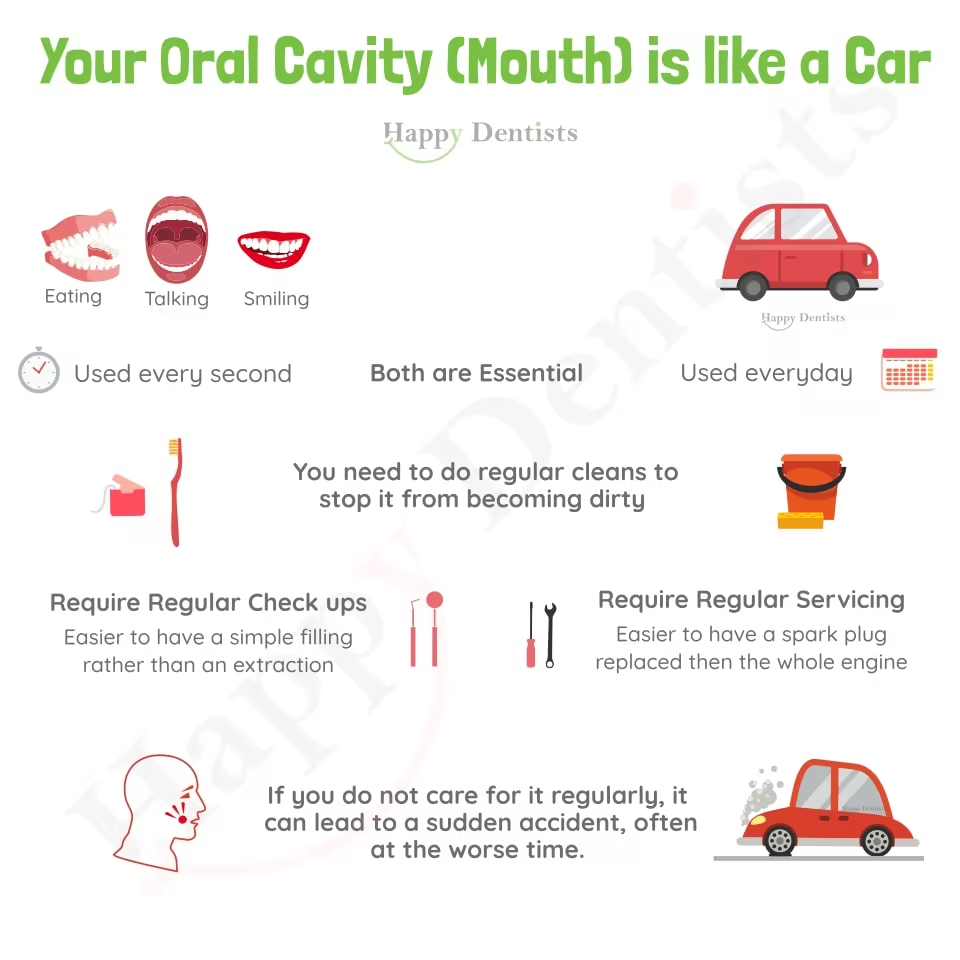Why Should I Care
You may be surprised at how often you use your mouth. It is
used for eating, however depending on how many teeth you
have, it can limit your options for example having steak. It
is used for talking but you only need to speak to someone
with dentures to notice the difference in their speech. It
is used for smiling of course. It is even utilized by your
face for facial features. Yes that is right, removing teeth
can result in what is called a sunken face. There is even
new research starting to show that there is a connection
with gum disease and diabetes. Fortunately there are options to help solve most of these issues but
obviously avoiding these in the first place is the best case
scenario. Therefore, follow the prevention tips on this
website and talk to your local health practitioner to help
you set up an effective prevention regime to limit the
chance of future issues arising.
What is the Restoration Cycle
The
tooth life cycle
or restoration cycle is the concept that the tooth is on a
continuum in terms of the options that are available if
problems arise. These options are important in keeping you
functioning and smiling. Although, unfortunately nothing
man-made is as good as the original biological tooth that
nature gave you. A filling can prolong the life of the tooth
but even after keeping it clean and monitoring it, it will need
to be replaced as just like all man-made objects it will
eventually fail. This may result in a slightly bigger
filling
which can prolong the time before you may have to
move to the next step. The aim is to stay on top of
maintenance and care by brushing at home and having regular
check ups. This reduces the chance of skipping steps on the cycle and
reducing your options later. For example, I have a filling
on one of my lower teeth. It is a small filling that I clean
and get checked yearly. At the moment it is doing well and
surprisingly has lasted 10 years which is a long time for
this type of filling. But I am aware that eventually it will
need to be replaced. If I don't care for it and miss
regular check ups, there is a chance that the decay might progress and I might be forced
to go further down the tooth life cycle and choose a crown
instead of a slightly bigger filling in the future. It is important to
acknowledge that this is just a guide and the options differ
for everyone based on their own individual factors.
Stages of the restoration cycle
Tooth Life Cycle Picture
Healthy Tooth
-
This is a tooth without disease or any restoration
Fissure Sealants
(To Learn More About This Click Here)
-
In some patients that have deep grooves in their tooth, a
small amount of sealant (like sealant used for grooves
between tiles) is used to seal these deep grooves. They
only last a few years but the aim is to make it easier to
clean by preventing plaque from getting stuck inside these grooves.
They are often reversible, once removed it returns to a
healthy tooth. Follow the link to find out more on this.
Fillings
(To Learn More About This Click Here)
-
Fillings are placed to prevent further progression of
decay/caries. It is used to limit the spread of decay
before it gets to a stage where you have to something more
drastic. It is important to understand that fillings do
eventually wear down, when this happens see your local
oral health professional to help replace it. Sometimes if
the decay.caries is left longer to progress this may
result in a larger filling. Follow the link to find out
more on this.
Dental Crowns
(To Learn More About This Click Here)
-
After a while, there may come a point where most of the tooth structure
has been replaced by fillings. At this stage it is often advised to get
one solid material, rather than multiple patches of
fillings. This can be an overlay which is a smaller crown
however this depends on the amount of tooth structure you
have available at that time.This solid material
can be a crown or an overlay, which is a smaller crown. Whether you get a crown or an overlay
depends on how much tooth structure you have available at that time. Crowns are also often
recommended to be placed after root canal treatment
because root canal treatment can weaken the inside of the
tooth, making the tooth more prone to fracture than a
healthy tooth. Follow the link to find out more on this.
Root Canal Treatment
(To Learn More About This Click Here)
-
If decay/caries has reached the pulp (nerve and blood
supply), then in order to keep the tooth, root canal
treatment is often recommended. This involves removing the
infected nerve and blood vessels and sealing it up.
Follow the link to find out more on this.
Implants
(To Learn More About This Click Here)
-
Whether you can get an implant depends on multiple factors. It involves placing
an artificial tooth via a screw which is 95% similar to
your original tooth. Often the down side is you do not get
the normal feedback that you would from your original
tooth. Follow the link to find out more on this.
Dentures
(To Learn More About This Click Here)
-
This option allows you to replace your teeth that have
been removed. It helps to re-establish the functions
mentioned earlier (talking, eating and smiling) however,
it is not the same as your original teeth. Biting force is
often 25% of normal biting force, and speaking can be
different from what you were used to. However, it is still
an improvement over no teeth. Follow the link to find out
more on this.


